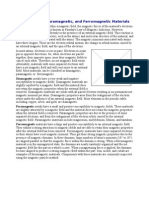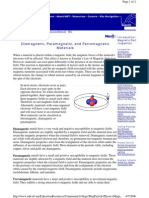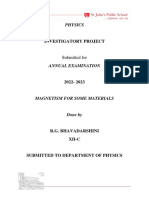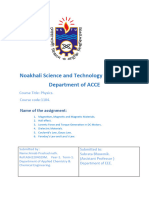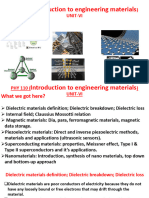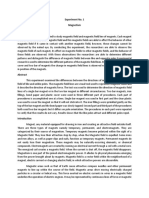0 ratings0% found this document useful (0 votes)
41 viewsPhy Diamagnetic
Phy Diamagnetic
Uploaded by
B BoysThe document discusses three types of magnetic materials:
Diamagnetic materials are weakly repelled by magnetic fields and do not retain magnetic properties when the external field is removed. Their electrons are paired, resulting in no net magnetic moment.
Paramagnetic materials are slightly attracted to magnetic fields but also do not retain magnetism after removal of the external field. They have some unpaired electrons and domains align when exposed to an external field.
Ferromagnetic materials strongly attract magnetic fields and can retain magnetism after the field is removed. They have many unpaired electrons within aligned magnetic domains, giving them a strong net magnetic moment even without an external field.
Copyright:
© All Rights Reserved
Available Formats
Download as DOCX, PDF, TXT or read online from Scribd
Phy Diamagnetic
Phy Diamagnetic
Uploaded by
B Boys0 ratings0% found this document useful (0 votes)
41 views2 pagesThe document discusses three types of magnetic materials:
Diamagnetic materials are weakly repelled by magnetic fields and do not retain magnetic properties when the external field is removed. Their electrons are paired, resulting in no net magnetic moment.
Paramagnetic materials are slightly attracted to magnetic fields but also do not retain magnetism after removal of the external field. They have some unpaired electrons and domains align when exposed to an external field.
Ferromagnetic materials strongly attract magnetic fields and can retain magnetism after the field is removed. They have many unpaired electrons within aligned magnetic domains, giving them a strong net magnetic moment even without an external field.
Original Description:
Physics
Original Title
Phy-Diamagnetic
Copyright
© © All Rights Reserved
Available Formats
DOCX, PDF, TXT or read online from Scribd
Share this document
Did you find this document useful?
Is this content inappropriate?
The document discusses three types of magnetic materials:
Diamagnetic materials are weakly repelled by magnetic fields and do not retain magnetic properties when the external field is removed. Their electrons are paired, resulting in no net magnetic moment.
Paramagnetic materials are slightly attracted to magnetic fields but also do not retain magnetism after removal of the external field. They have some unpaired electrons and domains align when exposed to an external field.
Ferromagnetic materials strongly attract magnetic fields and can retain magnetism after the field is removed. They have many unpaired electrons within aligned magnetic domains, giving them a strong net magnetic moment even without an external field.
Copyright:
© All Rights Reserved
Available Formats
Download as DOCX, PDF, TXT or read online from Scribd
Download as docx, pdf, or txt
0 ratings0% found this document useful (0 votes)
41 views2 pagesPhy Diamagnetic
Phy Diamagnetic
Uploaded by
B BoysThe document discusses three types of magnetic materials:
Diamagnetic materials are weakly repelled by magnetic fields and do not retain magnetic properties when the external field is removed. Their electrons are paired, resulting in no net magnetic moment.
Paramagnetic materials are slightly attracted to magnetic fields but also do not retain magnetism after removal of the external field. They have some unpaired electrons and domains align when exposed to an external field.
Ferromagnetic materials strongly attract magnetic fields and can retain magnetism after the field is removed. They have many unpaired electrons within aligned magnetic domains, giving them a strong net magnetic moment even without an external field.
Copyright:
© All Rights Reserved
Available Formats
Download as DOCX, PDF, TXT or read online from Scribd
Download as docx, pdf, or txt
You are on page 1of 2
Diamagnetic
materials have a weak, negative susceptibility to magnetic fields.
Diamagnetic materials are slightly repelled by a magnetic field and the material does
not retain the magnetic properties when the external field is removed. In diamagnetic
materials all the electron are paired so there is no permanent net magnetic moment per
atom. Diamagnetic properties arise from the realignment of the electron paths under
the influence of an external magnetic field. Most elements in the periodic table,
including copper, silver, and gold, are diamagnetic.
Paramagnetic materials have a small, positive susceptibility to magnetic fields. These
materials are slightly attracted by a magnetic field and the material does not retain the
magnetic properties when the external field is removed. Paramagnetic properties are
due to the presence of some unpaired electrons, and from the realignment of the
electron paths caused by the external magnetic field. Paramagnetic materials include
magnesium, molybdenum, lithium, and tantalum.
Ferromagnetic materials have a large, positive susceptibility to an external magnetic
field. They exhibit a strong attraction to magnetic fields and are able to retain their
magnetic properties after the external field has been removed. Ferromagnetic
materials have some unpaired electrons so their atoms have a net magnetic moment.
They get their strong magnetic properties due to the presence of magnetic domains. In
these domains, large numbers of atom's moments (1012 to 1015) are aligned parallel so
that the magnetic force within the domain is strong. When a ferromagnetic material is
in the unmagnitized state, the domains are nearly randomly organized and the net
magnetic field for the part as a whole is zero. When a magnetizing force is applied,
the domains become aligned to produce a strong magnetic field within the part. Iron,
nickel, and cobalt are examples of ferromagnetic materials. Components with these
materials are commonly inspected using the magnetic particle method.
Lenz’s Law:There is an induced current in a closed conducting loop if and only if
the magnetic flux through the loop is changing. The direction of the induced
current is such that the induced magnetic field always opposes the change in
the flux.///////// "An induced electromotive force generates a
current that induces a counter magnetic field that opposes the
magnetic field generating the current."
What is radioactivity?
Radioactivity is the property of some atoms that causes them to
spontaneously give off energy as particles or rays. Radioactive atoms emit
ionizing radiation when they decay.
Unstable atomic nuclei will spontaneously decompose to form nuclei with a higher
stability. The decomposition process is called radioactivity.
Nuclear binding energy is the amount of energy required to hold an atom's
protons and neutrons together in the nucleus.
The photoelectric effect refers to the emission, or ejection, of electrons from
the surface of, generally, a metal in response to incident light.
You might also like
- UNIT - 4 - ppt-1Document49 pagesUNIT - 4 - ppt-1Neha YarapothuNo ratings yet
- Magnetic Particle TestingDocument34 pagesMagnetic Particle Testingmnaseemiqbal4200No ratings yet
- Magnetic FieldDocument2 pagesMagnetic Fieldkhopo ALzainNo ratings yet
- Magnetic MeterialsDocument1 pageMagnetic MeterialsmpkkbtechNo ratings yet
- Diamagnetic, Paramagnetic, and Ferromagnetic Materials: Home - Education Resources - NDT Course Material - MPIDocument2 pagesDiamagnetic, Paramagnetic, and Ferromagnetic Materials: Home - Education Resources - NDT Course Material - MPIheartbreakkid132No ratings yet
- Advanced Morden Solid State Physics 4Document9 pagesAdvanced Morden Solid State Physics 4Edge of ScenesNo ratings yet
- Basic Principles of MPI TestingDocument48 pagesBasic Principles of MPI TestingManivannanMudhaliarNo ratings yet
- MPTDocument33 pagesMPTsanthoshm123098No ratings yet
- Engineering Physics Notes LpuDocument55 pagesEngineering Physics Notes LpuPrince RajNo ratings yet
- Magnetism and Matter ProjectDocument15 pagesMagnetism and Matter ProjectSubash ChandNo ratings yet
- Physics ProjectDocument10 pagesPhysics ProjectMandeep TanwarNo ratings yet
- Magnetic Properties of SolidsDocument2 pagesMagnetic Properties of SolidsZunair ArslanNo ratings yet
- Diamagnetism-WPS OfficeDocument2 pagesDiamagnetism-WPS OfficeQueennie GadutNo ratings yet
- Properties of Solid: Magnetic Property of SolidsDocument12 pagesProperties of Solid: Magnetic Property of SolidssharadNo ratings yet
- Magnetic materialsDocument7 pagesMagnetic materialssukritirc1267No ratings yet
- Magnetic Particle TestingDocument35 pagesMagnetic Particle TestingWALIDNo ratings yet
- Physics FinalDocument14 pagesPhysics FinalBhavadarshiniNo ratings yet
- Assignment of PhysicsDocument35 pagesAssignment of PhysicsArnab NathNo ratings yet
- Dielectric Magnetic PropertiesDocument2 pagesDielectric Magnetic PropertiessarengaminulNo ratings yet
- SNM 05Document7 pagesSNM 05Mazhar AliNo ratings yet
- Magnetic PropertiesDocument20 pagesMagnetic Propertiespatrick saliwanNo ratings yet
- Magnetic Particle TestingDocument34 pagesMagnetic Particle TestingYusuf BagewadiNo ratings yet
- Basic MagnetismDocument13 pagesBasic Magnetismnadjat_21100% (1)
- Physics Project MagnetismDocument27 pagesPhysics Project MagnetismDheekshith KumarNo ratings yet
- Magnetic Materials PDFDocument78 pagesMagnetic Materials PDFDilbagh Singh SidhuNo ratings yet
- Classification of Magnetic MaterialsDocument15 pagesClassification of Magnetic MaterialsDileep Singh100% (1)
- MPI - Magnetic Particle Inspection PresentationDocument64 pagesMPI - Magnetic Particle Inspection Presentationmahesh070100% (1)
- For Students - NDT - Magnetic ParticleDocument37 pagesFor Students - NDT - Magnetic Particleyogeshwaran2010928No ratings yet
- Pawan ChoudharyDocument33 pagesPawan Choudharyraianiket088No ratings yet
- Magnetic Properties of Materials DocsDocument6 pagesMagnetic Properties of Materials DocsJeterine Arias100% (1)
- Electric and Magnetic Fields (2) - Lecture 1 Spring 2021-2022Document21 pagesElectric and Magnetic Fields (2) - Lecture 1 Spring 2021-2022Ahmed tarek gaballahNo ratings yet
- MPI-NDT ModulDocument43 pagesMPI-NDT ModulAndi Dedi Aris YaningratNo ratings yet
- MT Self-Study NoteDocument153 pagesMT Self-Study Notenewdao100% (9)
- Magnetic Materials and Their TypesDocument9 pagesMagnetic Materials and Their TypesRahul YadavNo ratings yet
- Magnet AssignmentDocument2 pagesMagnet Assignmentlamsen110300No ratings yet
- The Effect of Temperature on the Strength of a MagnetDocument29 pagesThe Effect of Temperature on the Strength of a MagnetishikadparasharNo ratings yet
- Magnetism IGCSE PhysicsDocument44 pagesMagnetism IGCSE PhysicsKavya KothariNo ratings yet
- Engineering Materials PHY110 Unit VIDocument67 pagesEngineering Materials PHY110 Unit VIKundan KumarNo ratings yet
- SCIENCEDocument7 pagesSCIENCEJheiah UyNo ratings yet
- MagnitisumDocument22 pagesMagnitisumPrakhar VermaNo ratings yet
- Electromagnetism in Everyday LifeDocument12 pagesElectromagnetism in Everyday Lifemonanavarez10No ratings yet
- 2021 - Types of Magnets - Monday 22nd NovemberDocument14 pages2021 - Types of Magnets - Monday 22nd NovemberSheldon MusiinzaNo ratings yet
- MagnetismDocument39 pagesMagnetismBuse Temirr100% (1)
- Classifications of Magnetic MaterialsDocument3 pagesClassifications of Magnetic MaterialsNasha Agarwal100% (1)
- Sri Ramayanti - Tugas 2Document18 pagesSri Ramayanti - Tugas 2Sri Ramayanti SimanjuntakNo ratings yet
- Material Science Unit 4Document54 pagesMaterial Science Unit 4AMAN SINGHNo ratings yet
- Magnetism in Engg.Document4 pagesMagnetism in Engg.Naima SadiqNo ratings yet
- Magnetic PropertiesDocument6 pagesMagnetic Propertiesrajasuleman335No ratings yet
- Magnetic Properties of MaterialsDocument31 pagesMagnetic Properties of MaterialssoumyajyotideyNo ratings yet
- MagnetismDocument13 pagesMagnetismSyed Mairaj Ul Haq100% (1)
- Magnets and Magnetism Summary and NotesDocument2 pagesMagnets and Magnetism Summary and Noteszanzoon20000No ratings yet
- CH 7 MagnetismDocument8 pagesCH 7 MagnetismAnkit Singh RathoreNo ratings yet
- Compass For OOW Class IIIDocument260 pagesCompass For OOW Class IIIKyaw Mya OoNo ratings yet
- Machines Lab No. 1Document7 pagesMachines Lab No. 1Marvin Lucero FiscalNo ratings yet
- Unit 3 - Types of Magnetic MaterialsDocument16 pagesUnit 3 - Types of Magnetic MaterialsGigganiggaNo ratings yet
- Magnetic Particle Inspection Page4Document1 pageMagnetic Particle Inspection Page4Balram JiNo ratings yet
- Who Invented Magnets?Document5 pagesWho Invented Magnets?Mhea Nicole EscubidoNo ratings yet
- Physics for Kids : Electricity and Magnetism - Physics 7th Grade | Children's Physics BooksFrom EverandPhysics for Kids : Electricity and Magnetism - Physics 7th Grade | Children's Physics BooksRating: 5 out of 5 stars5/5 (1)



